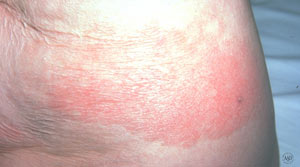Cutaneous T-Cell Lymphoma
Cutaneous T-cell lymphoma is a disease in which certain cells of the lymph system (called T-lymphocytes) become cancerous within the skin. Lymphocytes are infection and disease-fighting white blood cells that are made in the bone marrow and by other organs of the lymph system. Unfortunately, like all other cells of the body, lymphocytes can sometimes transform into cancer cells.

- The lymph system is part of the immune system. Lymph vessels carry lymph, a colorless, watery fluid that contains lymphocytes. Clusters of lymph nodes are found in the underarm, pelvis, neck, and abdomen. The spleen and the tonsils are also part of the lymph system.
- There are several types of lymphoma. The most common types of lymphoma are called Hodgkin's disease and non-Hodgkin's lymphoma. These types of lymphoma usually start in the lymph nodes and the spleen.
- Cutaneous T-cell lymphoma (CTCL) usually develops slowly over many years. In the early stages, the skin may be itchy and dry and dark patches may develop on the skin. In some cases, tumors may form on the skin. As more and more of the skin becomes involved, the skin may become infected. The disease can spread to lymph nodes or to other organs in the body, such as the spleen, lungs, or liver.
- The most common form of CTCL is called Mycosis Fungoides. When large numbers of the tumor cells are found in the blood, the condition is called Sezary Syndrome.
Once cutaneous T-cell lymphoma is confirmed by skin biopsy, more tests will be done to determine the stage of disease. Stage is important to plan treatment. Treatments for CTCL include the following:
- Topical corticosteroids, topical retinoids or topical chemotherapy
- Phototherapy (usually PUVA) in combination with topical therapies.
- Local electron beam or x-ray therapy.
- Interferon alfa (biological therapy) alone or in combination with other therapies.
- Oral targretin with topical therapies +/- interferon alfa.
- Total skin electron beam radiation therapy.
- Extracorporeal photopheresis (combined with other therapies).
- Systemic chemotherapy in advanced cases.
